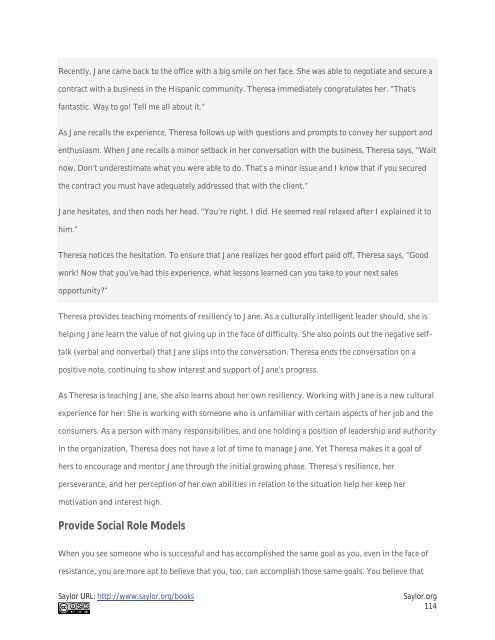Leading with Cultural Intelligence, 2012a
Leading with Cultural Intelligence, 2012a
Leading with Cultural Intelligence, 2012a
Create successful ePaper yourself
Turn your PDF publications into a flip-book with our unique Google optimized e-Paper software.
Recently, Jane came back to the office <strong>with</strong> a big smile on her face. She was able to negotiate and secure a<br />
contract <strong>with</strong> a business in the Hispanic community. Theresa immediately congratulates her. “That’s<br />
fantastic. Way to go! Tell me all about it.”<br />
As Jane recalls the experience, Theresa follows up <strong>with</strong> questions and prompts to convey her support and<br />
enthusiasm. When Jane recalls a minor setback in her conversation <strong>with</strong> the business, Theresa says, “Wait<br />
now. Don’t underestimate what you were able to do. That’s a minor issue and I know that if you secured<br />
the contract you must have adequately addressed that <strong>with</strong> the client.”<br />
Jane hesitates, and then nods her head. “You’re right. I did. He seemed real relaxed after I explained it to<br />
him.”<br />
Theresa notices the hesitation. To ensure that Jane realizes her good effort paid off, Theresa says, “Good<br />
work! Now that you’ve had this experience, what lessons learned can you take to your next sales<br />
opportunity?”<br />
Theresa provides teaching moments of resiliency to Jane. As a culturally intelligent leader should, she is<br />
helping Jane learn the value of not giving up in the face of difficulty. She also points out the negative selftalk<br />
(verbal and nonverbal) that Jane slips into the conversation. Theresa ends the conversation on a<br />
positive note, continuing to show interest and support of Jane’s progress.<br />
As Theresa is teaching Jane, she also learns about her own resiliency. Working <strong>with</strong> Jane is a new cultural<br />
experience for her: She is working <strong>with</strong> someone who is unfamiliar <strong>with</strong> certain aspects of her job and the<br />
consumers. As a person <strong>with</strong> many responsibilities, and one holding a position of leadership and authority<br />
in the organization, Theresa does not have a lot of time to manage Jane. Yet Theresa makes it a goal of<br />
hers to encourage and mentor Jane through the initial growing phase. Theresa’s resilience, her<br />
perseverance, and her perception of her own abilities in relation to the situation help her keep her<br />
motivation and interest high.<br />
Provide Social Role Models<br />
When you see someone who is successful and has accomplished the same goal as you, even in the face of<br />
resistance, you are more apt to believe that you, too, can accomplish those same goals. You believe that<br />
Saylor URL: http://www.saylor.org/books<br />
Saylor.org<br />
114


















